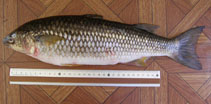| Family: |
Mugilidae (Mullets) |
| Max. size: |
36 cm TL (male/unsexed) |
| Environment: |
pelagic-neritic; freshwater; brackish; marine, catadromous |
| Distribution: |
Western Atlantic: North Carolina to Texas in the USA south to Venezuela, including the West Indies. |
| Diagnosis: |
Dorsal spines (total): 5-5; Dorsal soft rays (total): 8-8; Anal spines: 2-2; Anal soft rays: 9-9 |
| Biology: |
Inhabits pools and runs of small to medium rivers (Ref. 86798). Adults live in freshwater rivers and streams. Young are encountered occasionally in brackish waters. This is the only mullet that ascends far inland and spends all its adult life in freshwater (Ref. 11225). Tend to be few and solitary in upper streams, but form uneven schools in larger streams at lower elevations (Ref. 11225). Oviparous, eggs are pelagic and non-adhesive (Ref. 205). Usually spawn during the rainy season (Ref. 42119). Caught and consumed by local populations in some parts of central America. |
| IUCN Red List Status: |
Least Concern (LC); Date assessed: 15 January 2019 Ref. (130435)
|
| Threat to humans: |
harmless |
Source and more info: www.fishbase.org. For personal, classroom, and other internal use only. Not for publication.
